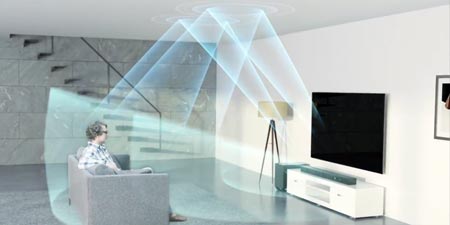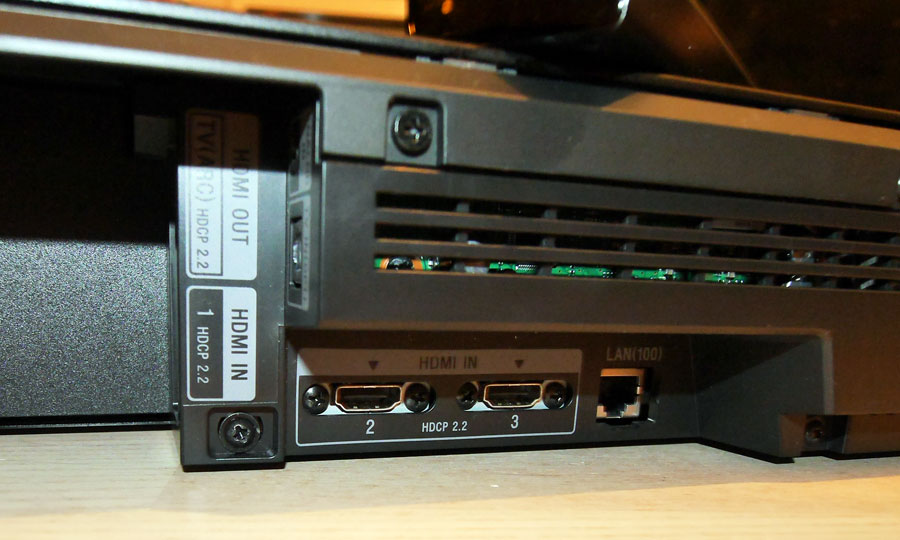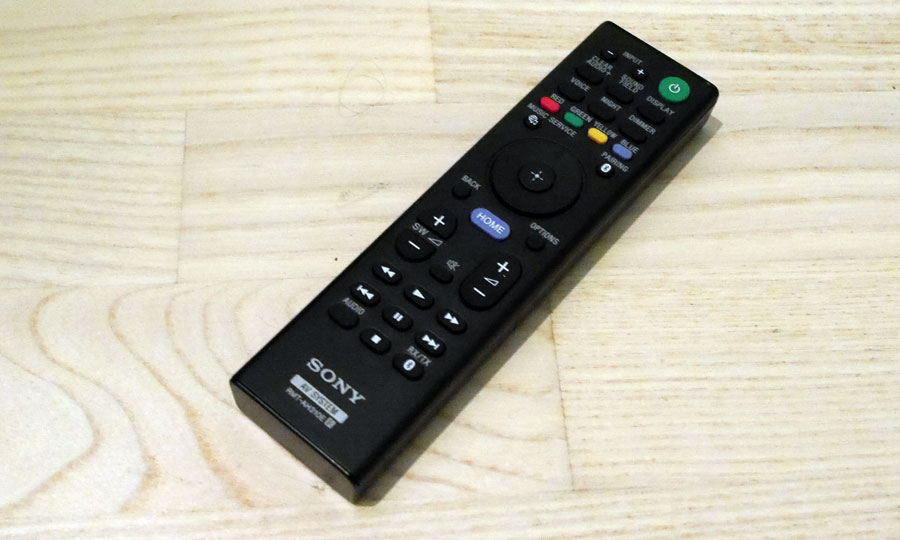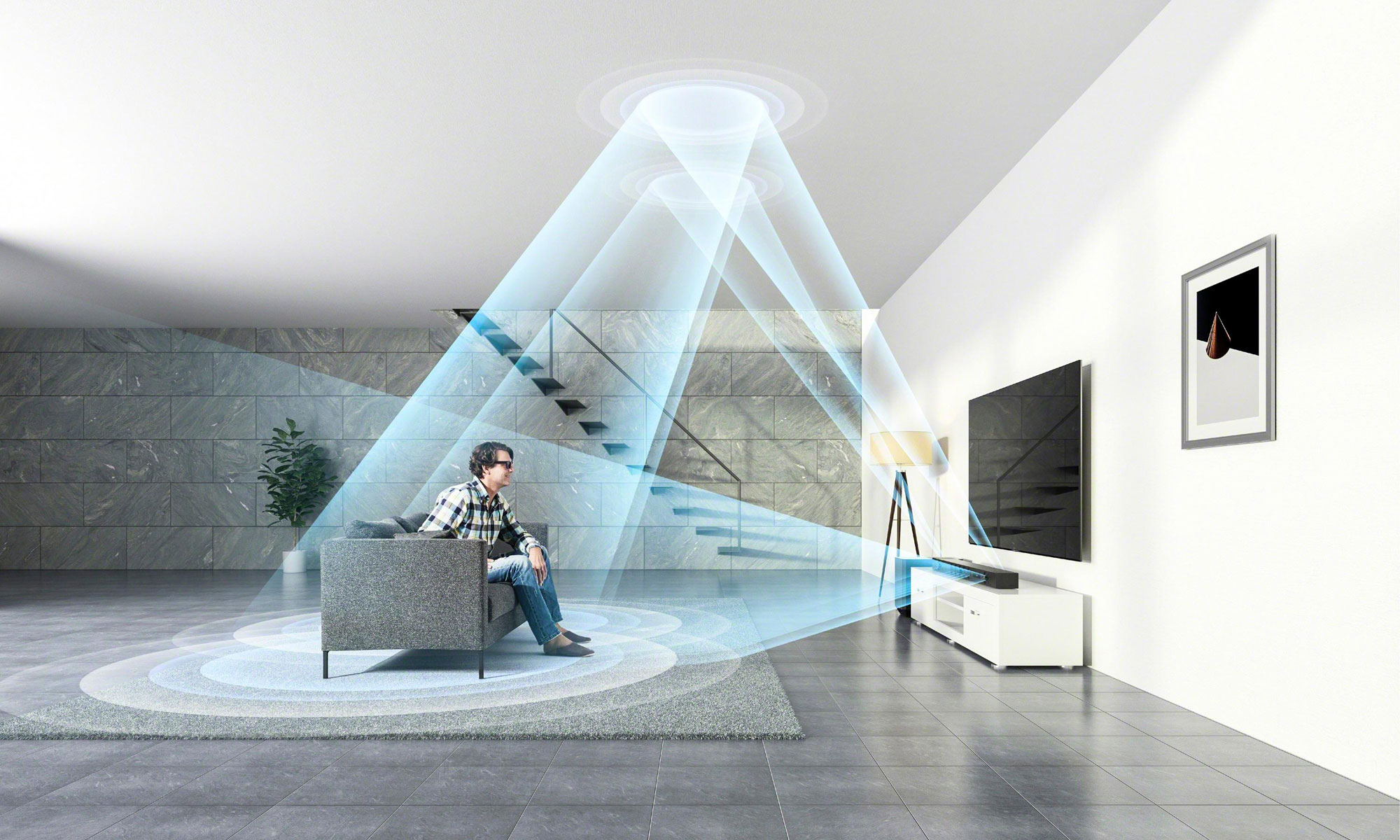Review: Sony HT-ST5000 (Atmos)
First impressions - Setup - Ports & formats - Atmos introduction - Sound - Movies - Sound - TV - Sound - Music - Conclusion
In recent years, soundbars with Dolby Atmos and DTS:X have emerged but what should you expect from these relatively compact speaker systems? Atmos is usually something we associate with cinema and tons of speakers. Can a soundbar form factor really deliver a convincing object-based audio experience at home and can you actually hear the helicopter flying over your head? Those are some natural questions when scaling down from a full-fat implementation to something that fits into a modern living room.
We have already reviewed Samsung’s first Dolby Atmos soundbar and with HT-ST5000 Sony has entered the arena. ST5000 is a premium-priced soundbar that was introduced in 2017 – and later updated to support DTS:X – but unlike Samsung’s version it has no rear speakers. Can Sony’s HT-ST5000 convince us? Here’s our review.Sony HT-ST5000 specifications
(HxWxD) 8 x 118 x 14.5 cm 8.2 kg 3x HDMI (2.0), 1x Ethernet, 1x USB 1x HDMI out (ARC) 7.1.2 channels
Dolby Atmos
Dolby TrueHD
DTS:X
DTS-HD MAWiFi (n standard)
Chromecast
Bluetooth
Spotify ConnectUser manual
Remote control
Optical cable
FeetSubscribe to our Newsletter, Facebook, twitter or RSS to receive notice when new reviews are publishedFirst impressions
When I received Sony HT-ST5000, the first thing that struck me was the sheer weight of the box. The packaging has a strange shape but if you have any experience with Sony’s soundbars that will hardly surprise you. Unboxing and setting up the product is pretty straightforward but there are no neat details here. Inside there is what you need to get started, including the soundbar, subwoofer, remote control, and manual.
Once set up, you will notice Sony’s conservative design approach. The soundbar is a rectangular box with slightly rounded edges around the metal grid to make it appear little less square-looking and generic. It is not a particularly bold design and it will probably not win any design awards.
Some of Sony’s other audio products ooze a more modern, almost Scandinavian design, so I had hoped that the company’s most premium soundbar would be a little more inviting considering its spot under the TV, which is often the center of the living room.
The subwoofer is perhaps a little more daring in its look. It has been designed in such a way that the base gives it an edgy look. The subwoofer also looks relatively potent in size, which may not appeal to everyone. However, a subwoofer today must have some volume to deliver good performance, so if you want a great effect, you must have a chamber with lots of air inside. A larger subwoofer will oftentimes give you a deeper and louder bass without distortion.
The remote control is another component that looks exactly like we had expected it to look. It is more or less the same ugly and cheap remote control that comes bundled with all of Sony’s products. I don’t think it is too much to expect a decent remote from a top-of-the-line product, especially considering what some competitors are offering.Set up
This is a plug-and-play product. The soundbar and subwoofer connect wirelessly. Nor app or internet connection is required. The process is fool-proof but the simple approach also means that you cannot expand the system to contain additional speakers, not even rear speakers. Subwoofer and soundbar are both active, meaning that they require a fixed connection to a power outlet, after which they will automatically initiate pairing. I think it is important to emphasize that you get what you see with HT-ST5000. It is not an expandable audio system.
By connecting the soundbar to the internet (WiFi or Ethernet) you can take advantage of audio streaming protocols such as Chromecast, and Spotify Connect. Setting up the internet features are easily done after you have connected power and HDMI to the TV.
So now you just need to figure out where to hide the unsightly subwoofer. Since it has a wireless link to the soundbar you can place it – almost – freely in your living room. Many modern subwoofers can lie down but the one that comes bundled with ST5000 must stand upright, and of course that takes away some flexibility.
The soundbar on the other hand must be fixed towards your listening position and you should place it directly underneath your TV for the optimal experience. If you have a corner sofa or two sofas not everyone will get the optimal listening experience. More on that later.Ports and formats
Some months after launching ST5000, Sony pushed out a firmware update that added support for the DTS audio format, including DTS:X, which is a direct alternative to Dolby Atmos. Initially, only Dolby Atmos object-based audio was supported. In the past, I have reviewed soundbars that refused to play nicely with primarily DTS, so Sony has made a wise decision to back both relevant formats.
In addition, we hear that Sony is planning yet another firmware update for HT-ST5000. Stay tuned for more info.
If I had to complain about something it would be that there are only three HDMI inputs, which I find insufficient. I think most people could easily use more HDMI inputs, especially considering that users who own a Atmos/DTS:X-capable soundbar, tend to also own a UHD Blu-ray player – besides set-top boxes, media streaming boxes, game consoles etc. You may suddenly find that having 3 HDMI ports is not enough.
Sony has included an optical cable in the box. Most of us probably have HDMI cables and Ethernet cables lying around but it still seems a little cheap not to include at least one with such an expensive product that requires HDMI to work to its full capability.
If you loop your playback devices through the soundbar you need the bundled remote control. Luckily, ST5000 also support HDMI CEC and Audio Return Channel (ARC) on HDMI 1 so you also get sound from HDMI devices connected directly to the TV. CEC was tested on a Sony TV and a Samsung TV and worked as expected. It allows you to control audio volume via TV remote.
However, the TV remote will only control audio volume on the soundbar via HDMI CEC. If you want to adjust the subwoofer level or change audio mode you are forced to pick up the soundbar’s remote.
The soundbar has various audio modes: Clear Audio+, 3D surround, Movie, Music, Sports, and Standard. Each mode has its own special – and often undesired – characteristics. For example, Clear Audio enhances treble too much, whereas 3D surround sounds fake. Movie is often a little bass heavy, while Sports enhances noise from fans and lowers commentator sound. My clear favorite is Standard. If you want to adjust the subwoofer’s role in the mix, you can do that with the dedicated buttons on the remote control.Dolby Atmos – an introduction
Since support for Dolby Atmos and DTS:X, and object-based audio in general, is the defining feature of HT-ST5000, and the headlining upgrade over the previous top-of-the-line HT-ST9, I thought it would be a good service to offer a short introduction to Dolby Atmos in the living room. And to see what has changed since our review of Samsung HW-KW950.
The short explanation is that Dolby Atmos, and DTS:X, is object-based audio technology. What this means is that the content creator can work with audio as “objects” and place these objects in a three-dimensional space. In addition, Dolby Atmos adds an overhead channel for added immersion. To date, TV audio has, roughly speaking, been defined as a horizontal pane without height information and confined to fixed speakers channels.
Of course, this puts extra demands on your audio equipment. In the most basic form, it requires your speaker setup to be able to reproduce overhead sound in order for you to hear a helicopter pass over your head. Typically, this involves installing overhead speakers, but while dedicated overhead speakers will produce the best effect, not everyone is prepared to turn their living room into a home theatre.
Another solution is to have up-firing speaker units that beam audio towards the ceiling that in turn can be used to reflect sounds towards the viewer. This solution is often found in consumer products designed for living rooms. And this is exactly what Sony is using in HT-ST5000. On the other hand, ST5000 lacks rear speakers.
As I briefly mentioned in my introduction, not all Atmos-enabled soundbars are capable of delivering good results. On common theme for soundbars is that they are using up-firing units and while we have seen some progress in the area, we have not yet reached the sweet spot. Perhaps Sony ST5000 will change our perspective on the matter.
Besides an Atmos-compatible soundbar you also need video content that has been mastered and made available in Dolby Atmos. I keep referring mainly to Atmos here but that is not to try and undermine the competing DTS:X but simply in recognition of the fact that Atmos is much more readily available to consumers.
Besides on UHD Blu-ray discs (and select HD Blu-ray discs), Dolby Atmos is available from Netflix, Vudu, and soon Apple iTunes and Amazon Prime. However, be aware that an Atmos soundtrack can be made available in either a high-quality lossless audio format (Dolby TrueHD), which is found on discs, or compressed lossy audio format (Dolby Digital Plus), which is used for streaming video. I should also note that very few TVs can output Atmos (via HDMI ARC) so you need a compatible player, too. Again, this could be either an UHD Blu-ray player or a streaming box.
I own an Xbox One that can output Dolby Atmos and in addition we hooked up a Sony UBP-X800 UHD Blu-ray player to the Sony ST5000 soundbar. In 2016 when we tested Samsung’s Atmos soundbar, the breadth of the movie library was a lot smaller than it is today. Most major movies released starting from 2015 and beyond now come with either Atmos or DTS:X soundtracks.
Dolby also maintains a list of movies with Dolby Atmos.Sound – Movies
With the soundbar, Sony sent us a copy of Dan Brown’s Inferno, which is a Columbia / Sony Pictures release. Since I had never gotten around to watching it, I thought it would be a good first play. I would characterize it as an action drama and while I have seen better from Tom Hanks and Ron Howard, it had a few good moments for testing an audio system, including audio effects that are meant to be reproduced in the overhead channel as well as audio effects that are meant to be reproduced right in the center of the room. This is where I first encountered what ST5000 and Atmos has to offer.
The effects were on point and I was able to pin-point them to within a diameter of around 2 meters inside a room spanning 5x5 meters in width/length and 2.5 meters from floor to ceiling. I encountered something that definitely took advantage of the object-based three-dimensionality of Atmos. I have heard Atmos in the cinema and on far more expensive setups and ST5000 obviously lacks precision compared to such setups but it is also much cheaper.
Another movie that will hardly be remembered as a classic is San Andreas but I like to use it for testing purposes. It is a disaster movie with countless explosions and helicopter sequences. Speaking of, I could clearly hear helicopters approach from a distance and pass over my head. I could also point out on which side of me the helicopter hovered at any given time while the camera was panning over the landscape. To me, this is one area where Sony beats the competition (soundbars) by delivering better precision.
Sony HT-ST5000 lacks rear speakers but it still manages to fill the room with tuneful sound. However, sounds that are supposed to come from the rear speakers are not accurately reproduced, as intended, and this is clearly ST5000’s Achilles’ heel. It is a shame because ST5000 delivers more believable overhead effects than its competition. On the other hand, Samsung HW-K950 comes bundled with rear speakers and is significantly cheaper.
The optimal solution would be for Sony to offer optional rear speakers and perhaps even height speakers that can be mounted slightly higher on the wall, closer to the ceiling, at an angle towards the viewer. This would potentially give almost the same effect as dedicated overhead speakers, and it would be a clear improvements compared to the built-in up-firing units implemented in the soundbar.
Sony hits back because the balance between the soundbar and subwoofer is fantastic. It is seldom that I listen to a soundbar without feeling the urge to fine-tune a string of parameters. But ST5000 delivers the neutral sound that I want, with bass that is well-tuned to volume, while midtone and treble together deliver just about the right amount of nerve in the actors’ voices.
The tweeter is capable of reproducing birds chirping in a way that sounds natural and believable, and combined with good midrange, ST5000 delivers clear and nuanced human voices. It manages to convey small nuances such as nervousness, excitement and joy in voices, without this being too dominant or theatrical. These are all characteristics of a good speaker.
If you crack up the volume too much, you will hear some distortion in the top notes but I did this mostly for the sake of stress testing the soundbar, and it occurred at the highest levels only so I do not consider it a practical problem. Very few people like to listen to movies at max volume.
The subwoofer can deliver mood music or effect with relatively precise bass and nuance. It can also deliver burst bass during explosions that can be felt in your stomach region. This is evidence of a quality subwoofer.Sound – TV
Of course, this is a simplification but movies and TV series often push a soundbar to play on all strings, including treble, midtones and bass, and in a harmonized way, whereas TV programs typically test the soundbar’s abilities mainly in the area of treble and midtones. When watching a TV channel you are often served a highly compressed signal as opposed to a Blu-ray disc, and oftentimes you will listen at lower volume. These conditions can, at times, reveal weaknesses in speakers, including distortion issues.
Distortion will not only make human vocals sound different – or wash away nuance – it can also result in human voices turning to mumble or the other end of the scale; lack of treble dynamic.
Luckily, ST5000 suffers from none of these issues and TV channels or TV programs are delivered without distortion in midtones and treble.
Equally interesting is the fact that ST5000 sounds great even at normal listening levels. Unfortunately, that is not always the case and while a soundbar may sound good at high volume, quality often reveals itself when you want to listen at lower volume. Is the sound still balanced, nuanced and clear? And yes, ST5000 fills the room with great and balanced sound even when you are watching TV programs, series, and movies at lower audio volume.
A soundbar has to be versatile. It is not enough that it can make the house shake when watching a movie on a Saturday evening. It should also deliver when you are watching sports, news, children’s TV, YouTube etc. ST5000 delivers but it brings us to the last phase of our evaluation, namely how ST5000 performs when challenged to play music, radio, and podcasts.
Sound – Music
A soundbar can be great for TV and movies but music is a different discipline. The way voices and notes mix together in music is not often mirrored in movies. We include an evaluation of a TV audio product’s music capabilities because many people tend to use their TV speaker for music, too. It is often the best speaker in the living room.
One pitfall is the subwoofer because for TV audio the subwoofer has often been tuned or trimmed to deliver deep rumble bass for explosions and action movies. This is very different from the bassline and drumbeat in a piece of music because as these move in the upper end of the frequency range, which the subwoofer accordingly has to handle, too.
It is a classic dilemma and one that can be hard for audio manufacturers to design for, or even prioritize for, but a quality subwoofer will get you far. I feared for ST5000’s accompanying subwoofer with its floor-facing subwoofer design because this tends to be a design intended for good movie performance and rumble true effects. This design is rarely suitable for music where you want to avoid rumble effects when the bass guitar fires. It has to be accurate.
Luckily, my doubts were quickly put to shame. The subwoofer is tuned to handle bongo drums as well as Brazilian salsa such as Red Hot Chili Peppers’ “slap bass”. It also handles tight rock drums from Disturbed.
The subwoofer met its match when subjected to very tight computer-generated drums, meaning electronic music. Considering this is a soundbar, I would call it an approved performance.
In the track See the Sky About to Rain by Neil Young from the previous millennium, his vocal is as clear and fragile as one could hope! Another singer who has a good voice for a test listening is Chris Cornell. His unique and slightly nasal vocal is easily recognizable and will therefore easily and immediately expose issues in the midtones but again ST5000 passed my trick test. It also passed Audioslave’s Cochise and another rock classic in the form of Soundgarden’s Fell on Black Days.
ST5000 did well as a music speaker. Of course, it cannot match a dedicated and good music speaker setup in the same price range but it outperforms many other soundbars by delivering music performance that it natural and lively. In addition, ST5000 has a multiroom function that allows you to expand audio to more rooms. We did not have any of the additional speakers required for this setup so we cannot comment further.Conclusion
Sony HT-ST5000 leaves me with a strongly positive impression. This is an all-round soundbar that decisively deals with most types of audio material. Its Dolby Atmos is probably best-in-class – at least based on what I have heard so far – and it delivers neutral and balanced sound, even at low and moderate audio volume. The subwoofer is neither too dominant nor too weak but rather well and finely tuned. It handles explosions as well drumbeats.
As an added bonus, ST5000 handles TV programs, in addition to movies, with bravour. It did not fail when challenged to play music either, which is often the case with soundbars tuned for movies.
But... The picky one will always find a hair in the soup and a set of rear speakers would have improved the listening experience noticeably. Sony has other multiroom products that allow users to add optional rear speakers so we are left wondering why the Japanese manufacturer has refrained from implementing the same option here. ST5000 even has multiroom functionality but the multiroom system is limited to expanding music playback to the kitchen or another room – it does not allow you to add rear speakers.
In addition, up-firing speakers meant to reproduce overhead audio effects as part of the Atmos experience clearly have limitations in terms of precision and audio quality. Today, this is a compromise that you have to live with if you want a simple Dolby Atmos setup. On the other hand ST5000 supports DTS:X, unlike many competing Atmos soundbars.
Now that we are standing in front of the wishing well, one might wish for an additional 2 HDMI ports (ST5000 has 3). A nicer remote control would not hurt either. Still, our biggest wish would be support for optional rear speakers and perhaps even better wireless speakers for overhead effects. The option to add rear speakers would have made ST5000 complete and leave competitors in the dust.Audio quality is assessed as overall audio quality, including treble, midtone and bass, as well as precision and balance. We also evaluate to what degree supported audio formats affect the overall audio experience.
Features is assessed based on functionality (ports, format support, wireless audio protocols etc.) as well as the applicability.
User experience is evaluated on the basis of user friendliness, speed, reliability, build quality, choice of materials, and day-to-day use of the product.
Total score is weighted: 50% Audio quality, 25% Features, 25% User experience.
All scores are calculated based on a moving maximum target, defined by what we currently consider the best on market. Each score is then presented as a percentage. This means that a score will fall over time as new and better products set new standards. This allows you to compare product scores across years. A score of 100% in a given category means that it is consider the best available product in this category to date.Click for a more detailed explanation of the score system and Awards.
Best-in-class Atmos
Neutral / balanced sound
Versatile – also for musicNo rear speakers (not even optional)
Only 3 HDMI inputs
Dated remote controlNearest competitors





















